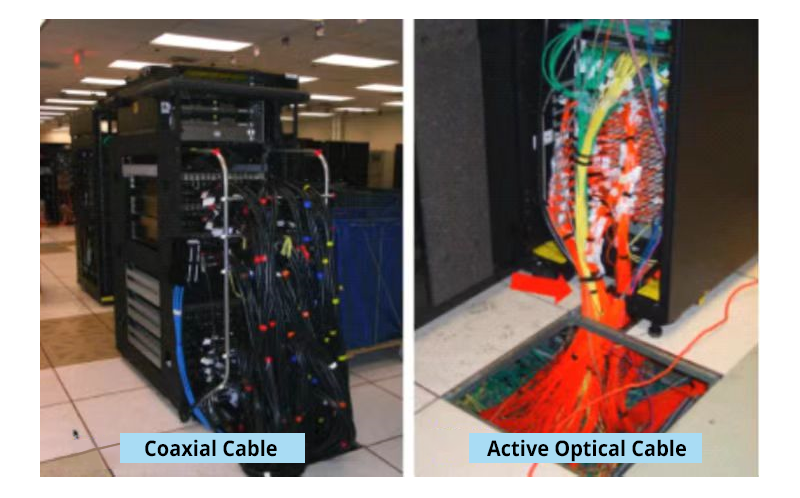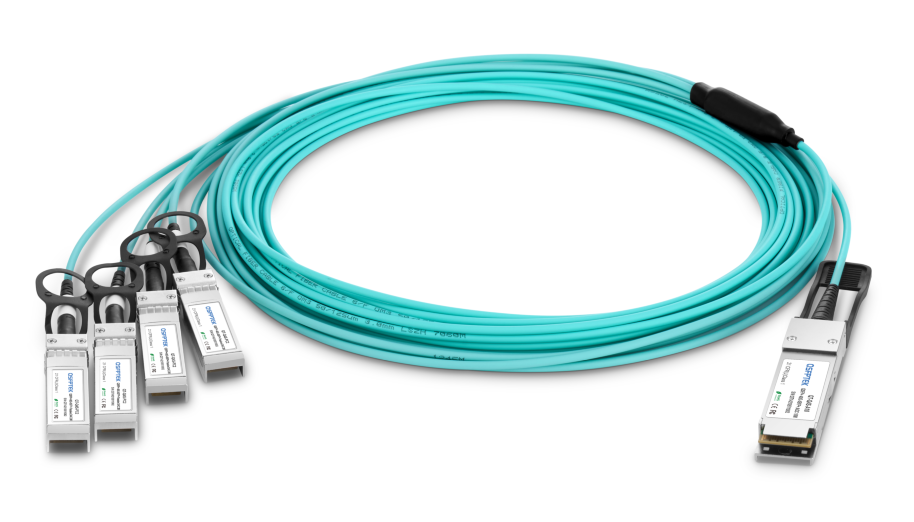The Most Comprehensive Guide to AOC Cable
What Is an AOC Cable?
AOC stands for active optical cable, composed of integrated optoelectronic devices, including two transceivers and one optic fiber cable. The two transceivers are pre-installed at both ends of the optical fiber cable. The transceivers at both ends are plug-and-play electrical interfaces.
AOC Cable Types
There are two forms of AOC products, integrated AOC cable, and breakout AOC cable. Integrated AOC has the same transceiver interface at each end, such as 10G SFP+ to SFP+ AOC cable, 40G QSFP+ to QSFP+ AOC cable, 100G QSFP28 to 100G QSFP28 AOC cable. Breakout cable type is special, such as 40G QSFP+ to 4x10G SFP+ breakout AOC cable, 100G QSFP28 to 4x20G SFP28 breakout AOC cable, which provides an efficient method for different types of interfaces interconnection.

Cisco compatible 10G SFP+ AOC Cable
Cisco compatible 40G QSFP+ to 4x10G SFP+ breakout AOC Cable
How AOC Cable Works
The main form factors of the transceivers include SFP+, QSFP+, QSFP28, etc. The three parts compose a whole part. Compared with separate components combination form of transceivers and fiber, the AOC cable system has better reliability. The structure diagram of the AOC active optical cable is shown below.
 Structure diagram of AOC active optical cable
Structure diagram of AOC active optical cable
How does the AOC cable work? The electrical signals are converted into optical signals through the electrical-optical converter transceiver. After modulation and coupling, the optical signal is input into the optical cable jumper and transmitted to the other end. At the other end, the optical signals will be decoupled and demodulated, finally restoring into electrical signals.
AOC Cable Transmission Media: Optical Fiber
AOC cable uses optical fiber as the transmission medium. What is optical fiber? Optical fiber is an important transmission medium, which can resist electromagnetic interference and has no electromagnetic interference. Optical fiber cable enables optical signals to reach a very long distance without distortion. It has a huge transmission capacity, and the single-mode fiber bandwidth can be as high as 50THz.
Advantages of Optical Fiber Communication
Large bandwidth and capacity. The single-mode fiber bandwidth can reach THz·km, which greatly expands the communication capacity.
Low transmission loss and long transmission distance. The minimum optical fiber loss has been reduced to less than 0.2dB/km, which is superior to any previous transmission medium. Due to the low transmission loss, the no-relay transmission distance in an optical fiber communication system is long. In an IM-DD (Intensity Modulation Direct Detection) fiber communication system, the relay transmission distance can reach tens to hundreds of kilometers and in a coherent communication system, the no-relay transmission distance can exceed 200km, which is too much longer than copper cable transmission.
Small volume and light weight. For example, the diameter of a 12-core optical fiber is only 12mm and its weight is only 90g/m. The lightweight and pliable features of optical fiber make it convenient for laying communication lines, such as direct burial, aerial, or inserting into the existing cable duct.
Strong disturbance-resistant. Fiber is a kind of dielectric waveguide, which has a waveguide structure and enables light waves transmission in a closed environment, so optical fiber is free from electromagnetic interference and can work in a strong electromagnetic field environment, such as used in power networks.
Why We Need AOC Cable?
Today, the widely used 10G/40G DAC (Direct Attach Cable) copper cable already become a hindrance to the data transmission since it has drawbacks in large weight, high transmission loss, limited transmission distance, and poor EMI (Electromagnetic Interference) immunity, and poor flexibility. The limitations caused by bandwidth and distance become more serious with the increasing development of cloud computing and HPC. Therefore, the market demand for AOC cables is emerging in recent years. And it is widely recognized that when the transmission distance is over 7 meters, AOC has incomparable advantages including smaller volume, lighter weight, easier bending, easier management, and longer transmission distance.
4 Benifits of AOC Cables
Easy Installation with Small Volume, Light Weight and Ductility
The volume and weight of the AOC cable are greatly reduced without changing the electrical interface. The diameter of the coaxial cable is generally more than 8mm and the weight is about 200g per meter, which is very bulky. However, the diameter of optical fiber used by the AOC cable is only 2mm, and the weight per meter is less than 20g, which is very easy to install.
The following figure presents the usage scenarios of coaxial cable and AOC cable used in the racks of the data center. It can be clearly detected that the coaxial cabling system is very cumbersome and has a very limited installation density while the AOC rack is very simplified and offers a higher installation density.

Comparison of coaxial cable and AOC cable used in data centers
Moreover, compared to the coaxial cable, the AOC cable has better ductility with a larger bending radius. The installation distance of AOC cable is only 70mm, which is much lower than 127mm of coaxial cable. Therefore, using an active optical cable can greatly simplify the installation process and improve the installation density.
Low Power Consumption
The power consumption of AOC cable is about only 50mw per Gbps, which is one-tenth of that of active copper cable. In addition, due to the small volume of active optical cable, the data center using AOC cables can reduce stress on cooling and power supply.
Longer Transmission Distance with Low Transmission Loss
Compared to traditional copper interconnection products, active optical cables have a high ability to be free of electromagnetism interfering so as to allow longer transmission distance. The transmission distance of an AOC cable can reach up to more than 100 meters, while the traditional copper cabling system only supports about 10 meters. For the copper cabling system, to extend the transmission distance, amplification and equalization devices are needed.
Safe and Convenient Interface
AOC cable uses the industry's widely used interfaces such as SFP+, QSFP+, QSFP28, etc. The users can replace traditional cables with active optical cables without changing any peripheral equipment and protocols, which greatly increases the efficiency of upgrading. Also, the AOC cable supports hot plug and play.
In terms of operating safety, since the two-end transceivers are pre-installed on the optical fiber without assembling, there is no need to worry about the eye damage caused by the laser.
Conclusion
Compared with traditional copper cables, active optical cables have superior data rate and distance advantages in end-to-end interconnection without electromagnetic interference problems and are more energy-saving, environmental-friendly, and safe. With the decrease in AOC cable costs, the AOC cable will be more widely applied, and it will play a more important role in end-to-end interconnection, expansion, and cloud computing. QSFPTEK can provide AOC cable products with wide compatibility and high performance, welcome to consult via [email protected].











